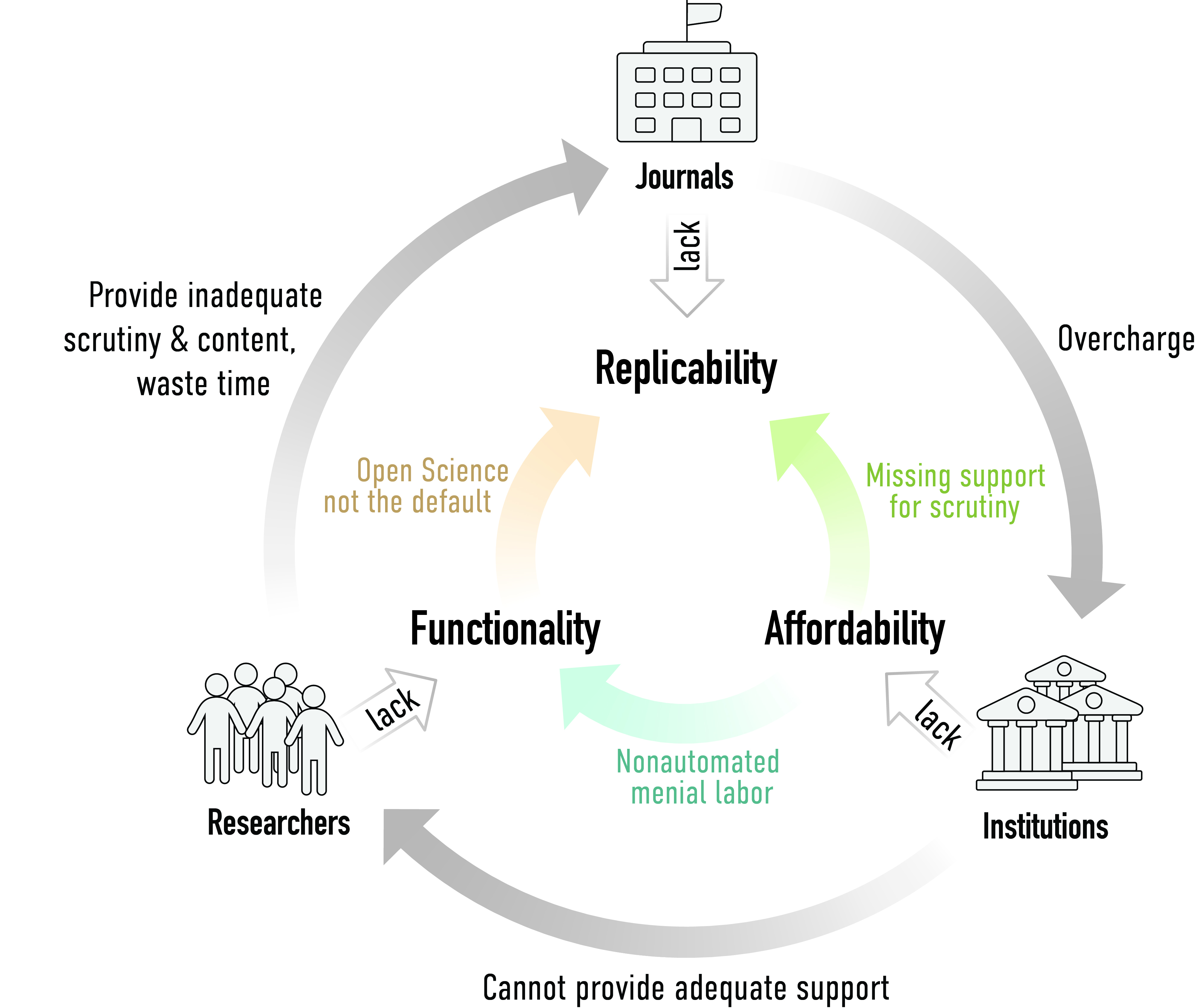Most academics would agree that the way scholarship is done today, in the broadest, most general terms, is in dire need of modernization. Problems abound from counter-productive incentives, inefficiencies, lack of reproducibility, to an overemphasis on competition at the expense of cooperation, or a technically antiquated digital infrastructure that charges to much and provides only few useful functionalities. Many a scholar have expressed the issue in terms of a social dilemma: the proximate interests of each individual actor, be it institution or individual are not aligned with the distal interests of the collective knowledge creation process. In other words, collective action is needed, where multiple actors act collectively in order to mitigate against the potential detrimental effects for each individual actor. This insight has been articulated for various aspects of scholarly reform, be it our literature, research quality, or scholarship in general. Collective action solutions can have various implementations from a simple aspiration such as “if only everybody would do X” to a contractual agreement among individuals to form a collective with a specific purpose, goals and means or strategies to achieve them. They all have in common that a sufficient number of actors need to act simultaneously enough in order to overcome the proximal obstacles.
Most of the numbers to express the size of this collective action problem are not so difficult to obtain. The main actors in this problem are of course individual researchers, but also the institutions at which they work and here in particular their libraries which hold the purse strings for much of the digital infrastructure that is in need of reform. Finally, research funding agencies (funders) not only provide key incentives for researchers but also decide which institutions are eligible for funding.
Citing OECD statistics, the 2018 STM report lists about 7.1 million full-time equivalent researchers globally. Given that many of these will be part time employees and sites like ResearchGate list about 17 million users, adding at least 50% to these 7 million or a total of about 11 million currently active, individual researchers is probably required for a lower bound estimate.
The number of universities is likely a reasonable approximation for the number of libraries. Webometrics lists about 30,000 universities globally.
The number of funding agencies is less easy to estimate. There is no list of funding agencies. The organization of research funding varies between countries such that research funds come both directly from the research institution and from funders that are often national, but also international in reach. Funders can be governmental or philanthropic. With about 200 countries in the world and each country with at least one, possibly more funding agencies, 400-500 funding agencies with at least roughly comparable influence over institutions and individual researchers is probably a reasonable estimate.
Taken together, we are looking at more than ten million researchers, 30,000 institutions but not even 1,000 funding agencies. These numbers only denote relative sizes as only the end of the collective action problem is given by the absolute size of the collective. The number required to start collective action in a way that leads to pervasive reform is not known. Given the massive disparities between research intensive countries and the rest of the world, whatever the this theoretical fraction of the collective joining the “early movers” will likely by further reduced if the “early movers” were largely composed of actors from leading research nations. Thus, if one considered only the most ‘influential’ 10% of all actors needing to be involved for a snowball effect of change to sweep the globe, the numbers change to one million researchers, three thousand institutions or just 40 funders. Thus, even at such dramatically reduced sizes, both individual researchers and their institutions appear as unreasonably large targets for any meaningful short to mid-term impact. Funders, however, not only represent a manageable size for a collective action problem, they ought to also have an intrinsic interest that their money is spent with the interest of the public in mind and not necessarily that of the individual researchers as long as it remains at odds with that of the public that provides the funds.
All of these numbers corroborate a well-known realization, flippantly formulated below:
What could funders do in order to initiate collective reform? Clearly, the mission of funding agencies is to fund research projects, not infrastructure. Just spending their money on infrastructure instead of research projects would be contrary to their mission and deteriorate the already in many places already precipitously low funding rates. If anything, funding agencies should increase their funding rates and not decrease them even further below already unhealthy levels. Funding agencies have a range of orthogonal options to shape research policies at institutions at their disposal. For instance, funders set very specific eligibility criteria that institutions need to fulfill in order for their members to receive grant funding. If these eligibility criteria were to exclude institutions which fund or otherwise support counter-productive incentives, irreproducible science or wasteful and dysfunctional infrastructure, these institutions would be incentivized to become eligible again. Funding agencies could thus use their eligibility criteria to reward and penalize desired and counter-productive institutional policies, respectively. Historically, such eligibility criteria have been used very effectively to ensure minimum infrastructure standards. Today, just like seemingly everything in this domain, these criteria just urgently need an overhaul. Some funders are already updating their policies in this regards, such as the DFG, the Wellcome Trust or the Templeton World Charity Foundation.
The question remains whether other funding agencies are aware of their power and willing to initiate the procedures required for modernizing their eligibility criteria? The formation of initiatives such as “Plan S” shows that the general understanding of the need for modernization together with a willingness for collective action is present in some of these funders. The general feasibility of such a “Plan I” (for infrastructure) was also already acknowledged. With understanding, general willingness and feasibility established, it remains to be seen if funding agencies consider the current threats to publicly funded science serious and urgent enough to warrant the effort to improve their eligibility criteria.
Thus, institutions need to modernize their infrastructure such that researchers are enabled to modernize their scholarship. They have now had more than 30 years for this modernization and neither of them have acted. At this point it is fair to assume, barring some major catastrophe forcing their hands, that such modernization is not going to magically appear within the next three decades, either. Funders, therefore, are in a position to incentivize this long overdue modernization, not by mandating 11 million individuals, but by mandating institutions to finally implement long overdue modernizations – modernizations which institutions and hence researchers have been too complacent or too reticent to tackle.
If we are faced with a collective action problem, as I would tend to agree, and the size of the collective is the major determinant for effective problem solving, then it is a short step to realize that funders are in a uniquely suited position to start solving this collective action problem. Conversely, then, it is only legitimate to question the motives of those who seek to make the collective action problem unnecessary difficult by advocating to target individual researchers or institutions. What could possibly be the benefit of making the collective action problem numerically more difficult to solve?
















Dear Björn,
I think your argument is a little naive about funders. Take, for example, the DFG (“the self-governing organisation for science and research in Germany”): a) self-governing means that its decision making represents the lower common denominator of interests of German professors b) it has acquired the task to administer the funding and governance of the NFDI (the German “National Research Data Infrastructure). And guess what is explicitly *not* being funded: Existing (including internationally well regarded) infrastructure! Or the so called EOSC – of which an eminent person joked, that is is neither European, not Open, nor scientific, nor a cloud: This is mainly just an extension of funding for long-running European projects – some, which have only marginal relevance to a true cloud infrastructure, such as high performance computing, or which have failed to attract a significant number of users (EGI).
Both initiatives suffer from the same syndrome: They are constructed such that money can be distributed more or less evenly, or according to (regional, institutional) quotas. This is then rationalized or hidden behind an ideology of “federated systems” …
I am afraid that, given these circumstances, individual scientists will “vote with their feet” and use commercial offerings better suited to their (immediate) needs – be it journals of the behemoths or the Google Earth Engine for Earth science data.
There is another type of collective which is less numerous that scientists or their institutions: The “scientific communities” – which is a little fuzzy concept, but perhaps most clearly embodied in (scientific) societies or disciplinary conferences or such. I actually do think that only agreements on this level – how to do trustworthy science, and how to communicate it – actually has the power to steer people, institutions, and, yes, funders towards the proper thing to do (and to fund). Think of the Bermuda Principles, as an example.
Dear Hans,
thank you very much for your comment. I’m not quite sure I understood your comment correctly. I never wrote anywhere that funding agencies should fund infrastructure? In fact, I’m strongly opposed to funding agencies funding infrastructure! Institutions ought to fund all basic research and provide the necessary infrastructure for it. I’m not even sure funding agencies ought to pay any overhead at all. If funding agencies would fund special projects only, that exceed the capacity of institutions, and use all their money to that end, this should increase success rates substantially. So no, funders definitely should not fund infrastructure! One way to direct funds would be if funders penalized institutions (e.g., by making them ineligible to receive grants) for wasting money on journals. Once journal payments are stopped, institutions have about ten times more money than they need for publishing and can use the remaining 90% to fund all the other infrastructure that is long overdue.
Among funders, the DFG stands out with their “Kodex” for good scientific practice in that it specifically requires a large fraction of the modern infrastructure. German universities need to implement the “Kodex” in a legally binding way and at our institution I’m working with a dedicated group of colleagues towards an implementation that empowers researchers to demand such infrastructure from university leadership, in case they fail to provide it.
Thus, if anything, the DFG is further along the route to demand institutions to modernize their infrastructure than nearly any other funding agency in the EU.
I agree that the EOSC is more of a political stunt than a solution to our problems at this time, but I know some of the people involved in steering this huge ship and they recount massive political struggles at the helm between academics and business interests. I’m not sure the last word is spoken, yet, about the final design of this project, but it doesn’t require much expertise to agree that the construct right now leaves much to be desired.
WRT “scientific communities” driving change: of course, smaller collectives can be quicker to act. However, generally, this tends to lead to a Balkanization of initiatives, mostly driven to fill specific needs, rather than serving the larger community. Examples include, but are not limited to proliferating, non-interoperable preprint silos, multiplying data repositories, code on sourceforge, GitHub or various GitLab instantiations (e.g., institutional or EUDat), etc.
> question the motives of those who seek to make the collective action problem unnecessary difficult by advocating to target individual researchers or institutions
I’m not sure I get your point. Funders alone cannot solve everything alone, either. So I think what you’re saying is that, instead of managing a problem collective action of researchers, one should aim for collective action of funders, which will be catalysts of collective actions by institutions, which will be catalysts of collective action by individual researchers. But how is that different from, say, what the NIH has been doing for over a decade? The initial coordination might be “numerically less difficult” but the problem remains the same.
I think the only difference is that the funding agencies, being a smaller group, could more easily be coordinated by a single project/entity. Someone with an infinite money printing machine could tell all funding agencies that the will match their entire funding, adding 50 % to it, if they commit to implement a very strong version of plan I, and presumably that could happen rather quickly. (But then, the same person could just buy up all the legacy publishers, release the entire sci-hub under cc-by and then shut down the same publishers overnight, liquidate them and transfer all their assets to the Internet Archive or something for preservation.)
I apologize if I wasn’t perfectly specific. I guess I wanted to keep the post short and only summarized some of the actions that funders could take, as I have written more details in the posts I reference in the appropriate places. This is, I guess, an ingrained habit where we often write in our papers “experiments were performed as previously described” and then just reference older work. This is how I wrote here as well.
As you can tell from the referenced posts, at least to my knowledge, the NIH has never excluded an institution from grant funding because they didn’t implement, say, a data archive or a software-sharing platform, or because they kept paying more for journals than for their own publishing solutions, where they could host tenders instead of secretly negotiating shady deals.
Of course, I’m always eager to learn of policies anywhere (besides those I explicitly mention) that do reward institutions which invest in modern infrastructure and penalize those that keep propping up a counter-productive legacy system?
The DFG, for instance, now will not allow members of any German institution that does not guarantee at least a ten-year raw data archive to apply for funding. There is still a long way to go, but this is a small step in the right direction, especially with all the other components in the same direction in their new “Kodex”.
You are correct in that I hope for a snowball effect: if funders were able to force institutions to drop journal payments in favor of a distributed system that allows for an actual market with competition to emerge, lost f things would change. For instance, there is plenty of evidence that most members of an institution begin by using the tools offered by the institution. If researchers would have to pay themselves for anything not covered by their institution and journals would not exist any more without money, most of the most pressing problems in scholarship would actually be solved, as researchers simply used the system provided for them and realized that it is both technically and socially much more advanced, time-saving and convenient to use than what they were forced to use in the bad old days.